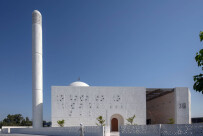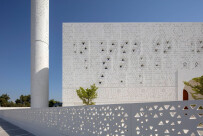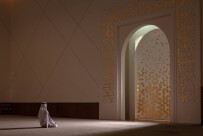The Mosque of the Late Mohamed Abdulkhaliq Gargash (Dubai, UAE) is a contemporary place of worship that quietly and masterfully employs form, materiality and controlled natural light to evoke a sense of calm and spiritual connection as the worshipper transitions from the outer material world to an inner sense of being. The Mosque is one of the first in the UAE to be designed by a female architect – Principal Architect and Founder Sumaya Dabbagh of Dabbagh Architects.

Simplifying the traditional typology of Islamic form and stripping it away to its essence, Dabbagh Architects sought to avoid multiple blocks in the building’s overall form. In the process of design development, the main building volume was separated into two: firstly, the prayer block containing the male and female prayer areas, and secondly the service block where the ablution facilities and residence for the Imam (the leader of prayer) and Moazen (caller of prayer) are found. As a result of this division, a courtyard is formed which has a sculptural canopy reaching out to reconnect the two volumes together. With its two arms almost touching, the canopy gives a sense of separation of the functional and the more sacred: the practicality of the ablution ritual and the spirituality of prayer. In further contrast to traditional mosque architecture, the minaret is designed as a separate volume.

The building is clad in a triangular pattern, which refers to traditional Islamic geometry but is reinterpreted in a modern language. The exterior panelling uses this triangulated pattern in recessed and perforated elements, which gives the building’s skin a dynamic appearance.

Internally, these perforations scatter natural light into the areas of worship with great control and care to illuminate the key spaces and create a calm atmosphere and sense of connection to the divine, as well as helping to cool the mosque’s interior. The double skin dome also allows natural light to enter, filtering it through the internal decorative skin, which incorporates the same triangulated pattern as the rest of the building. This filtered light creates a soft naturally-lit prayer space tailoring to the introspective mind during prayer.
Upon entering the mosque, perforated shading creates a threshold of perforated light leading the worshipper to the ablution area. There, the physical cleansing invites the clearing of the mind and preparation for prayer. The play of pattern and materiality in this project enhances the visitor’s experience and throughout, the architect sourced materials from the mosque’s locality, including stone from Oman, concrete, aluminium, cladding, joinery, and ceramics from the UAE.

Once inside the prayer hall, the visitor further transitions to a contained space where reading from the Quran may take place before prayer. All the while, the quality of light from one space to another changes to enhance the preparation process so that when the worshipper finally enters the main hall, they are ready for prayer. “Muslim prayer is performed throughout the day at prescribed timings: at dawn, midday, afternoon, sunset and at night.
This discipline creates a human connection with the natural day and night rhythm. The experience created through the design of the mosque seeks to enhance this connection through a controlled introduction of natural lighting,” explains Sumaya. This is done in three ways: vertically, via the perforated dome to enhance the spiritual connection to the heavens, the shafts of light from the narrow openings on the sides further create a sense of illumination from the divine; indirectly, behind the Mihrab to highlight the point of focus in the prayer hall facing the direction of prayer; and, through a play of light from a series of small openings in the façade that follows the same decorative patterns of the interior.

“At the end of each project, my hope is that the building will evoke the feelings and emotions that were envisioned at the outset. There is a defining, magical moment when the building is born and claims a life of its own. For this, my first mosque, that moment was particularly moving. I feel truly blessed to have had the opportunity to create a sacred space that brings people together for worship,” says Sumaya.






































